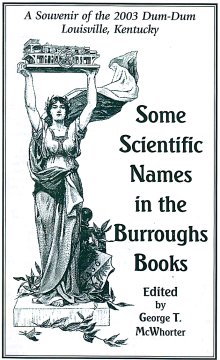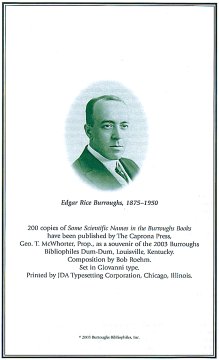AMUNDSEN, ROALD (1872-1928): Norwegian
polar explorer who discovered the South Pole and fixed the position of
the North Magnetic Pole. His journals are referred to by Jason Gridley
in his search for a polar entrance to Pellucidar. (Tarzan at the Earth's
Core)
ANDREWS, ROY CHAPMAN (1884-1960): American naturalist
and explorer, born in Beloit, Wisconsin; director of the American Museum
of Natural History in New York City from 1935-1942. He explored Asia, Alaska
and the Malay seas, discovering many fossil beds and plants and animals
previously unknown to science. ERB writes: "I believe that it was Roy Chapman
Andrews who said that adventures were the result of incompetence and inefficiency,
or words to that effect." (The Wizard of Venus)
APOLLONIUS (247-204 B.C.): Greatest of the Greek
mathematicians who introduced the standard terms used in the study of celestial
mechanics such as "ellipse" and "parabola." He did researches in Lunar
theory and one of the volcanic craters of the moon is named for him. He
is mentioned by Julian 5th in his attempt to identify the volcanoes of
the moon. (The Moon Maid)
ASTRONOMY: ERB writes "Just bear in mind that man
inhabited the earth for countless ages before it occurred to anyone that
the earth was a globe; and that within recent historic times men were subjected
to the Inquisition, broken upon the rack, drawn and quartered, burned at
the stake for holding to any such iniquitous theory (heliocentric)." For
background reading, see Andrew Dickson White's A History of the Warfare
of Science with Theology in Christendom (NY, Appleton, 1896)
BEEBE, CHARLES WILLIAM (1877-1962): American ornithologist
and explorer writer of Galapagos (1923), Beneath Tropic Seas
(1928), and many other books. He was born in Brooklyn and became Director
of Tropical Research at the New York Zoological Society, while exploring
Central and South America, the West Indies and the Orient. Penelope Leigh
tells her husband that they wouldn't be in their present awful predicament
if he hadn't read Beebe's Arcturus Adventure (Tarzan and the Castaways)
BORDA, JEAN CHARLES (1733-1799): French mathematician
and astronomer mentioned by Julian 5th as contributing to the nomenclature
of lunar volcanoes. He was noted for his study of fluid mechanics and the
development of instruments for navigation and geodesy. (The Moon Maid)
CELSUS, AULUS CORNELIUS (ca. 1 B.C.): Great Roman-physician
who is sent by the Emperor Tiberius to attend Caligula in A.D. 23. He was
a Latin encyclopedist who wrote De Re Medcina in 30 A.D. which consisted
of eight books on medicine. (I Am a Barbarian)
COOK, CAPTAIN JAMES (1728-1799): Famous English
explorer and a favorite of Burroughs who causes him to discover Thandar's
Island in 1773. He charted the coasts of New Zealand, Australia and New
Guinea, as well as the Pacific coast of North America as far as the Bering
Strait. He was killed in Hawaii by natives in a scuffle over a stolen boat.
(Cave Girl, Land of Terror)
COPERNICUS, NOCOLAUS (1473-1543): Father of modern
astronomy born in Torun (then in Prussian Poland). His masterpiece De
Revolutionibus showed that the planets of our solar system revolve
around the sun, a heretical view in his time. His young pupil, Rhetticus,
saw the book through the press in 1543 and gave Copernicus a copy while
the great astronomer lay on his deathbed. ERB mentions that a crater of
the moon is named for Copernicus. (Pirates of Venus)
CURTIS, GLENN HAMMOND (1878-1930): American inventor
and aviation pioneer who established the first flying school in New York
in 1909. He invented ailerons and built many planes for the allied nations
in World War I. ERB makes him the aviation teacher of Bowen J. Tyler, Jr.
(The Land That Time Forgot)
DARWIN, CHARLES ROBERT (1809-1892): Great English
naturalist and author of The Origin of the Species. He is cited
as a heavy influence on the researches of "God" in Tarzan and the Lion
Man. ERB was a great Darwinist, and mentions him often in his
books. Tarzan watches a drunken revelry at the king's palace in Athne:
"He felt disgust and shame . . . shame, because he belonged to the same
species as these creatures. Since infancy he had been fellow of the beasts
of the forest and the plain, the lower orders; yet he had never seen them
sink to the level of man. Most of them had courage and dignity of a sort;
seldom did they stoop to buffoonery, with the possible exception of the
lesser monkeys, who were most closely allied to man. Had he been impelled
to theorize he would doubtless have reversed Darwin's theory of evolution."
(Tarzan and the City of Gold)
DOBLE, ABNER (1890-1961): Founder of the Doble
Steam Motors Corporation in Emeryville, California (1924-1932). He produced
the finest steam car anywhere in the world. It had a condenser which gave
a range of 1,500 miles on 24 gallons of water. It sold for $8,000 and carried
a three-year warranty. 11,000 orders were received in 1917, but the war
priorities stopped the project. Doble was a perfectionist who could never
mass produce his cars which had parts that were all custom-made, so not
more than 40 cars were ever assembled. He tried to interest the aviation
industry in steam locomotion, but was thwarted at every turn. He had proved
that steam cars were more efficient than gasoline operated cars, but gas
was "in" and steam was "out." (Resurrection of Jimber-Jaw)
EDISON, THOMAS ALVA (1847-1931): Great American
inventor of the automatic telegraph, phonograph and light bulb who held
over 1300 American and foreign patents for his inventions. ERB suggests
that the nameless creature who first created fire by artificial means was
greater than Edison. (Land of Terror)
EINSTEIN, ALBERT (1879-1955): Great theoretical
physicist and enunciator of the special theory of relativity. He was born
in Ulm, Germany, became a Swiss citizen at age fifteen; a German citizen
in Berlin in 1914. He was deprived of his citizenship and his property
confiscated by Hitler in 1934. He then became a naturalized citizen and
won the Nobel Prize in Physics (1921-22). ERB writes: "She saw the Lural
Az curving upward, like Professor Einstein's time and space, until it was
simply lost in the distance." (Savage Pellucidar)
ELLSWORTH, LINCOLN (1880-1951): American polar
explorer from Chicago who accompanied Amundsen in the 1926 polar expedition
from Spitzbergen aboard the airship "Norge." He is referred to by Jason
Gridley during his search for a polar opening to Pellucidar. (Tarzan
at the Earth's Core)
EUCLID (ca. 300 B.C.): Greek mathematician who
taught at Alexandria. His Elements (13 books on geometry) are his
most enduring works; his greatest contribution was the use of deductive
reasoning in mathematics. One of his famous postulations was corrected
independently in the 19th century by Lobatchevsky and Bolyai and Riemann,
giving the rise to the field of study known as non-Euclidian Geometry.
(The Rate Book Department of the University of Louisville owns rare and
valuable first editions of Euclid, Bolyai, Lobatchevsky, Riemann, Copernicus,
Newton and Einstein.) Briannicus observes: ". . . but that which gave me
the greatest pleasure of all was a study of the amazing works of Euclid,
the great Greek geometrician." (I Am a Barbarian)
FLAMMARION, NICOLAS CAMILLE (1842-1925): French
astronomer and founder of the French Astronomical Society in 1887. He made
a special study of the moon, Mars and double-star systems. John Carter
observes: "Long ago, I believed with Flammarion that Mars was habitable
and inhabited; then a newer and more reputable school of scientists convinced
me that it was neither." (Swords of Mars)
GALILEO, GALILEI (1564-1642): Italian astronomer
and physicist recognized as the inventor of the telescope. En route to
Jupiter, John Carter remarks: "There were those scientists, for instance,
who clung to the Ptolemaic System of the universe, and who, after Galileo
had discovered four of the moons of Jupiter in 1610, argued that such pretended
discoveries were absurd, their argument being that since we have seven
openings in the head -- two ears, two eyes, two nostrils, and a mouth --
there could be in the heavens but seven planets. Having dismissed Galileo's
absurd pretentions in this scientific manner, they caused him to be thrown
in jail." (Swords of Mars)
GAMA, VASCO DA (1469-1524): Portuguese explorer
commissioned by King Emanuel I to sail by sea to India. He made the first
recorded voyage from Western Europe around Africa to the east, and established
colonies at Mozambique and Sofula. ERB makes him the brother of Cristoforo
da Gama, king of Alemtejo. (Tarzan the Magnificent)
GRIMALDI: Bowen Tyler's description of a prehistoric
humanoid race encountered in Caspak: ". . . on a plane of evolution between
that of the Neanderthal man and what is known as the Grimaldi race." This
is the Italian homo sapiens, "Grimaldi" being the name applied by prehistorians
to a culture of the upper Paleolithic Period, after the Grottes de Grimaldi,
a group of caves near Menton, France, but on the Italian side of the frontier.
The Grimaldi culture extends down to the heel of Italy where it occurs
at Romanelli, near Otranto. (The Land That Time Forgot)
HATCHER AND HOLLAND: Tom Billings refers to the
diplococus of Caspak as "infinitely different . . . from the crude restorations
of Hatcher and Holland." John Bell Hatcher (1861-1904) was the author of
Diplodocus which was published at the Carnegie Institute in 1901.
William Jacob Holland (1848-1932) published his Osteology of Diplodocus
Marsh (1906) with special reference to the restoration of the skeleton
at Carnegie institute. These two archaeologists were responsible for all
available knowledge relating to diplodocus. (The Land That Time Forgot)
JEANS, SIR JAMES HOPWOOD (1887-1946): English mathematician,
physicist and astronomer who developed the tidal hypothesis of the origin
of the earth. He was one of the most outstanding popularizers of science.
He wrote: "The evidence, for what it is worth, goes to suggest that Venus,
the only planet in the solar system outside Mars and the Earth on which
life could possibly exist, possesses no vegetation and no oxygen for higher
forms of life to breathe." ERB writes: "Even if the suggestion of Sir James
Jeans is born out by fact, each of Venus's days and nights is several times
as long as ours on earth. . ." (Pirates of Venus)
LAMARCK, JEAN BAPTISTE PIERRE ANTOINE de MONET
(1744-1829): French naturalist noted for his theories on evolution, which
provided the basic premise for Darwin's study. He is mentioned by "God"
as an early influence of his career at Oxford University. (Tarzan and
the Lion Man)
LOVEJOY AND COLTON: Authorities on hog breeding
in America. Shannon Burk tells Custer Pennington: "I've spent hours in
the office reading Lovejoy and Colton." Andrew James Lovejoy was born in
1845 and, in 1914, published his Forty Years' Experience of a Practical
Hog Man, teaming up with Foster Dwight Coburn (not "Colton," as ERB
apparently mistyped) to produce the Sal-Vet Swine Book (1912),
undoubtedly the manual to which ERB refers. He raised Berkshire hogs at
his Tarzana Ranch for several years. (The Girl from Hollywood)
MAGELLAN, FERDINAND (1480-1521): Portuguese navigator
who discovered and explored the Philippines, Spice Islands, and the Strait
of Magellan. ONe of his ships completed the first circumnavigation of the
globe. He was killed on the island of Mactan in the Philippines. (Land
of Terror)
MARE SERENITATIS: Although Galileo was the first
to apply general topographical features to the moon (such as "mare" and
"terrae"), Giovanni Riccioli and his pupil Grancesco Grimaldi officially
named the "Mare Serenitatis" of the moon in their 1651 moon map. (Pirates
of Venus)
MARE TRANQUILITATIS: A sea of Mars named by Giovanni
Riccioli (1564-1642) and Francesco Maria Grimaldi (1618-1663) in 1651.
In describing the lunar landscape viewed by Carson Napier, ERB writes:
"Tycho, Plato, and Copernicus stood out in bold relief upon the brazen
disc of the satellite, deepening by contrast the shadows of Mare Serenitatis
and Mare Tranquilitatis." (Pirates of Venus)
MENDEL, GREGOR JOHANN (1822-1884): Famous Austrian
monk noted for his work on heredity. ERB introduces him as an Austrian
naturalist from Brunn who, in 1856-1857, meets and exchanges ideas with
the creature later known as "God" in his African retreat in the Valley
of Diamonds. Through cross-pollination experiments, Mendel was the first
to formulate a scientifically accurate study of hybrids. (Tarzan and
the Lion Man)
MOLYNEUX, WILLIAM (1656-1698): French philosopher
and writer on optics who sent John Locke his theories concerning visual
perceptions. He felt that perception was innate, and the only way to test
it would be to deprive an individual from birth of all visual sensory
experience; when restored, the individual would be tested again. His theories
were not taken seriously until the 20th century. His 1692 treatise Dioptrica
Nova was translated as "vision, touch, and the philosophy of perception."
He published his own version of Decartes' Meditations. His son,
Samuel Molyneux (1689-1728) continued the work in his study of reflecting
telescopes. ERB writes: "Hilda was now a beautiful young woman, from whose
pulchritude the art of Molyneux had certainly detracted nothing." (The
Lad and the Lion)
PILTDOWN MAN: Human fossil remains found in Sussex,
England in 1908, originally believed to be one million years old. X-rays
taken in 1950 proved that the jaw and canine tooth were a hoax, while fluorine
tests taken at the same time showed that the Piltdown man was only 50,000
ears old. (The Land That Time Forgot)
SECCHI, ANGELO (1818-1878): Italian astronomer
mentioned by ERB as a pioneer in identifying the volcanoes of the moon.
(The Moon Maid)
SIKORSKY, IGOR IVAN (1889-1972): American aeronatical
engineer born in Kiev, Russia. He emigrated to the USA in 1919 and was
naturalized in 1928. He built and flew the first multimotored plane in
1913 and established the world's endurance record for sustained flight
in a helicopter of his own design in 1941. He was awarded the National
Medal of Science for his work on the development of the helicopter. (Pirate
Blood)
ST. JOHN, CHARLES EDWARD (1857-1935): American
astronomer born in Allen, Michigan and died in Pasadena, California. He
worked at the Yerkes Observatory and Mount Wilson Observatory mainly in
solar physics. He revised the monumental Rowland's Table of Solar Spectrum
Wave-Lengths (1928) and was President of the Solar Physics Commission.
He made spectroscopic observations of Mars and Venus, mainly to find oxygen
and water vapor in their atmospheres. ERB writes: "St. John had estimated
that the amount of oxygen above the cloud envelope that surrounds Venus
is less than one tenth of one percent of the terrestrial amount." (Pirates
of Venus)
STANLEY, SIR HENRY MORTON (1841-1904): His original
name was Henry Rowlands and he was born in Denbigh, Wales. He achieved
fame as the explorer who found David Livingston in 1871. His best known
books are Through the Dark Continent (1878) and In Darkest Africa
(1890), both of which ERB studied with fascination. In Tarzan and the
Golden Lion, ERB creates an interesting character called "The old man"
who is supposed to have come with Stanley to Africa from Wales (as a stowaway).
He befriends Tarzan and La and is made king of the Valley of Diamonds after
the Bolgani rulers are deposed. (Tarzan the Magnificent, Tarzan and
the Golden Lion)
TIMKIN AND FISHER: ERB refers to H. H. Timkin,
Chairman of the Timkin Roller Bearing Company of Canton, Ohio. From 1912-1944
they produced a series of 28 handbooks, journals and annual reports to
which ERB subscribed. "Fisher" refers to Charles T. Fisher, Vice-President
of General Motors Corporation in Detroit. In a whimsical mood, ERB describes
"La Diablesa" as a human engine worthy of respect with "body by Fisher,
bearings by Timkin." (Pirate Blood)
WRIGHT BROTHERS: ORVILLE (1871-1948) and WILBUR
(1867-1912) were the celebrated American aviation pioneers whose historic
flight at Kittyhawk in 1903 initiated the era of aviation. (Tarzan's
Quest)
ZEPPELIN, COUNT FERDINAND von (1838-1917): Noted
manufacturer of German airships. He had fought in the American Civil War.
ERB describes the "Zeppelin" which was built at Friedrichshafen and propelled
by Helium gas, used by Gridley and his party to find the polar opening
to Pellucidar. (Tarzan at the Earth's Core)

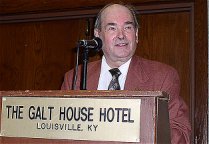
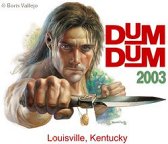
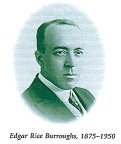 Burroughs
was a prolific reader and researcher, and his own works reflect his reading
interests. They contain hundreds of references to historic, literary and
scientific figures, mixed in with his own imaginary names and situations.
This is how he shared his enthusiasms with his readers and became one of
the most popular writers in America. I have culled a few scientific allusions
from his books to create this 2003 Dum-Dum souvenir.
Burroughs
was a prolific reader and researcher, and his own works reflect his reading
interests. They contain hundreds of references to historic, literary and
scientific figures, mixed in with his own imaginary names and situations.
This is how he shared his enthusiasms with his readers and became one of
the most popular writers in America. I have culled a few scientific allusions
from his books to create this 2003 Dum-Dum souvenir.

